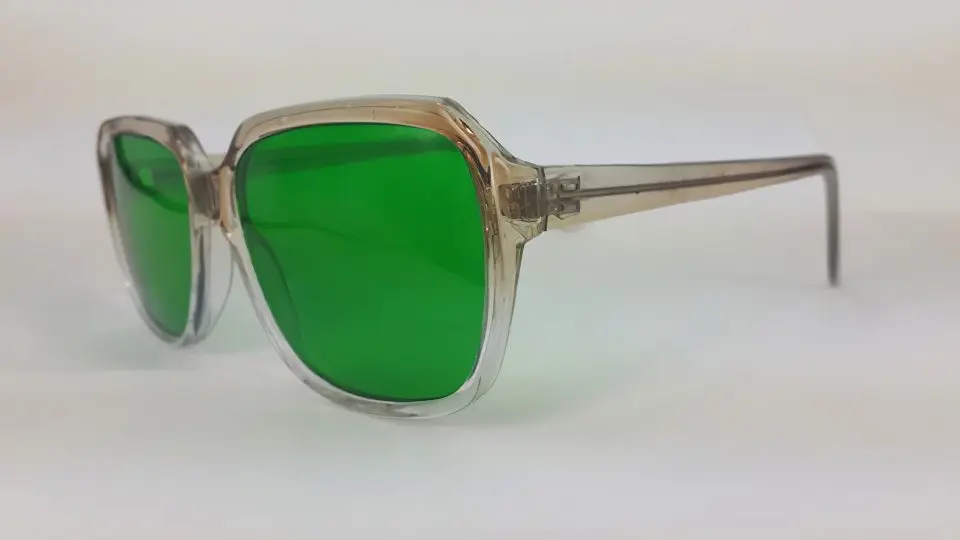Contents
Glaucoma is a disease that affects the organs of vision. The main reason for its occurrence is an increase in intraocular pressure against which the circulation of intraocular fluid is disturbed. The optic nerves undergo necrosis, which leads to visual impairment, up to complete blindness. Therefore, glaucoma requires treatment, which must be started immediately.
It is important to know the symptoms of glaucoma so as not to miss the onset of the disease. A timely appeal to the doctor will allow you to choose the right treatment and prevent the development of serious complications.
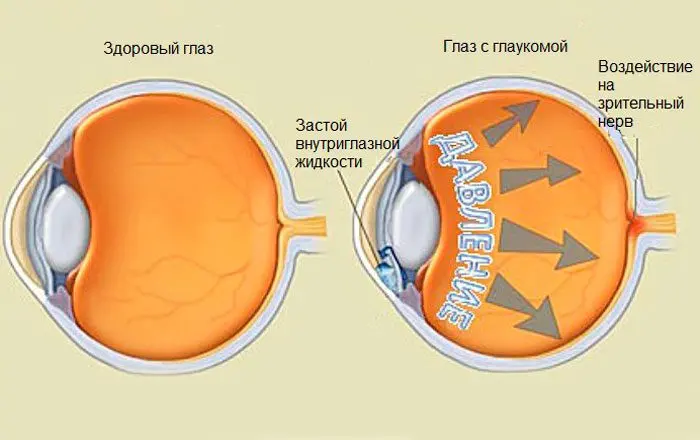
Types of glaucoma and their symptoms
Open angle glaucoma
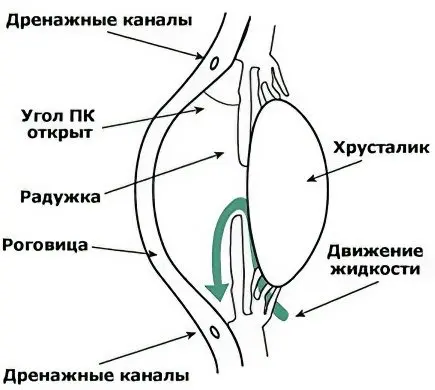
open-angle glaucoma – This is the most common disease, compared with other forms of glaucoma. The front of the eye with this shape looks standard, but a lot of fluid accumulates in the eye itself, and because of which there is an increase in eye pressure. This is due to the fact that the fluid does not find the desired outflow. As a rule, the attending specialist prescribes a medicine in order to lower intraocular pressure, but this does not always help. In this regard, it is necessary to perform the operation using a laser or using other surgical devices.
Symptoms of open-angle glaucoma can be difficult to identify. This is especially true for the early stages of the disease. It is able to progress for a long time, but it will not give any obvious manifestations. Intraocular pressure does not rise much, so a person does not notice these rises. At the same time, the structures of the eye continue to suffer. Obvious symptoms of the disease may appear at the last stage of the development of glaucoma, when it will no longer be possible to prevent vision loss. Only during this period a person turns to the doctor.
The first signal of vision problems is the appearance of bright circles around objects. Such a border will shimmer with all the colors of the rainbow. You should also pay attention to headaches and eye pain. Glaucoma often causes blurred vision and blurring of objects.
The older a person is, the more likely they are to develop glaucoma. Therefore, for preventive purposes, people over 40 are advised to visit an ophthalmologist once a year. This must be done even if no symptoms of the disease are observed.
Angle-closure glaucoma
Angle-closure glaucoma – This is glaucoma, which occurs when some of the front parts of the eyeball are disturbed, and this leads to severe pain in these places. At the same time, there is also a narrowing of the space between the iris and the cornea of the eyeball, and the fluid inside the eye does not find an outflow. If the outflow is impossible, there is a very strong intraocular pressure. In closed-angle glaucoma, the patient experiences severe pain in the eye, while in open-angle glaucoma, the patient does not experience any pain. With this form of the disease, headaches, nausea, vomiting, iridescent circles in front of the eye, and its redness occur. An acute attack of glaucoma is an urgent condition that requires the immediate initiation of adequate treatment. If you do not start treatment, a person can lose sight in a few hours.
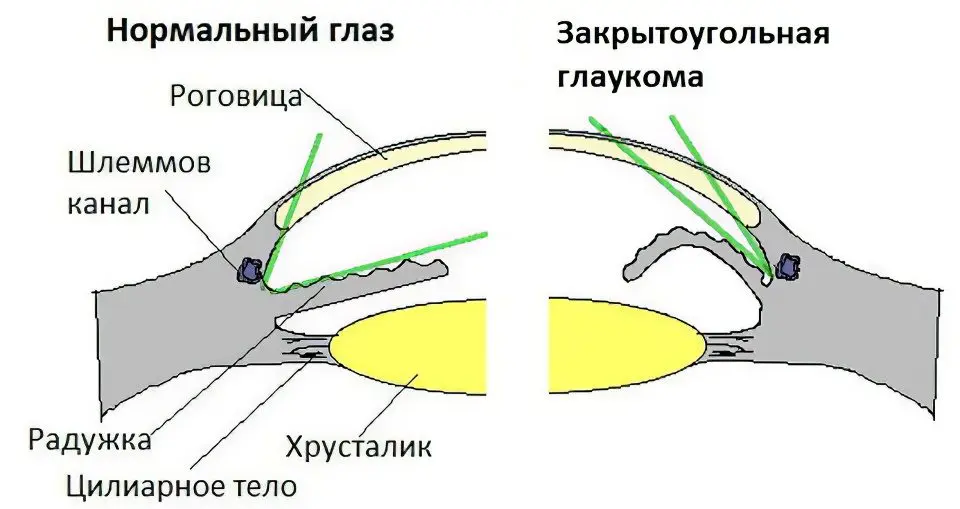
Difficulties faced by the patient:
A person cannot tilt his head down. The more often he does this, the higher the likelihood of developing severe complications.
A ban is imposed on work in those rooms where the air temperature remains at high levels all the time.
In the dark, at dusk and in low light, the patient should not strain his eyesight.
A person must strictly control the amount of fluid that he consumes during the day.
Any drugs that can provoke pupil dilation or an increase in intraocular pressure should not be taken.
Symptoms that indicate angle-closure glaucoma:
Visual impairment, blurry objects.
Pain that focuses on the eyebrows and eyes. It occurs with a certain frequency.
The appearance of a bright rainbow rim around any light sources and even around ordinary objects.
Change of acute periods of illness to periods of calm. The absence of symptoms is not a sign that glaucoma has stopped progressing. Vision continues to fall.
Narrowing and closing of the angle of the anterior chamber of the eye. With a significant increase in intraocular pressure, the patient’s white becomes very red, the cornea swells. This symptom can be noticed even by an ordinary person, without medical education.
Mixed glaucoma
In patients with this form of the disease, not only is the outflow of intraocular fluid difficult, but the angle of the anterior chamber is also blocked.
Secondary glaucoma
Secondary glaucoma Glaucoma is caused by inflammation, trauma, surgery, diabetes, tumors, and certain medications.
congenital glaucoma
congenital glaucoma – this is a consequence of malformations of intrauterine development, occurs, as a rule, in children. Treated through surgery.
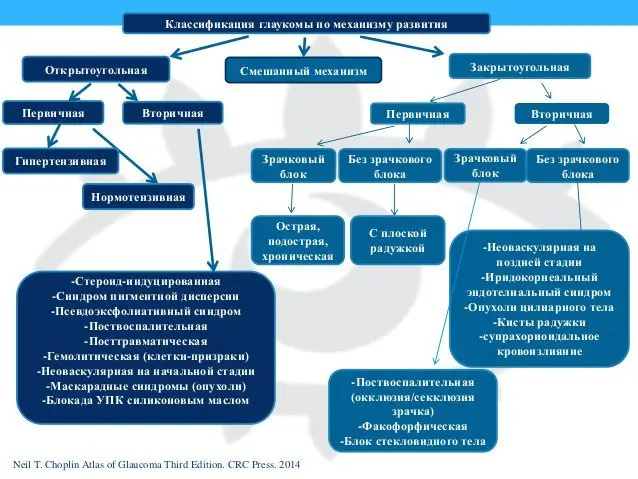
Risks of developing glaucoma
The likelihood of developing glaucoma increases in the following categories of people:
Smokers, people suffering from alcoholism. These bad habits lead to a regular increase in intracranial pressure.
People who don’t eat well.
People who thoughtlessly and without medical supervision take medications. It is important to tell your doctor about your illness. Sometimes the cause of blindness is a simple understatement. So, a team of doctors, who came to the call about an attack of hypertension or bronchial asthma, administer Eufillin to the patient. It exacerbates glaucoma and the person loses sight. Therefore, every doctor who prescribes treatment should report his illness.
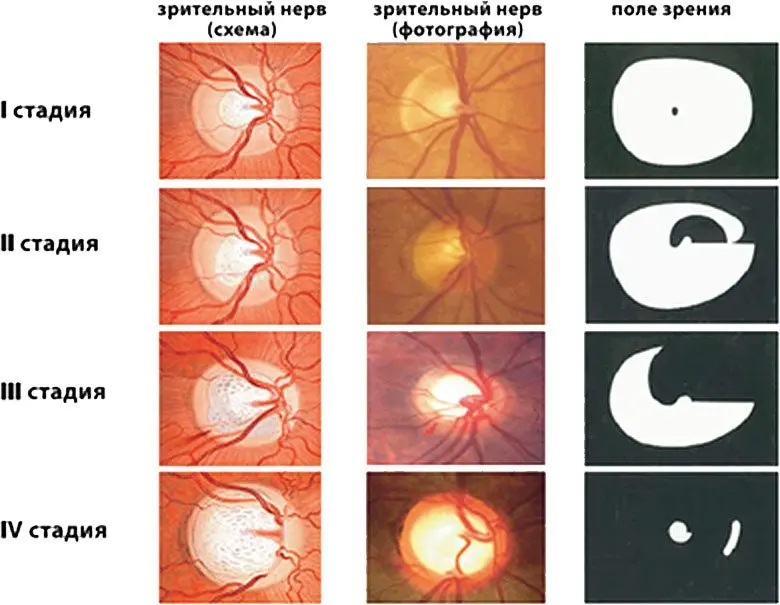
The first symptoms of glaucoma development
It is necessary to elaborate on the symptoms of glaucoma, which appear very first. These include:
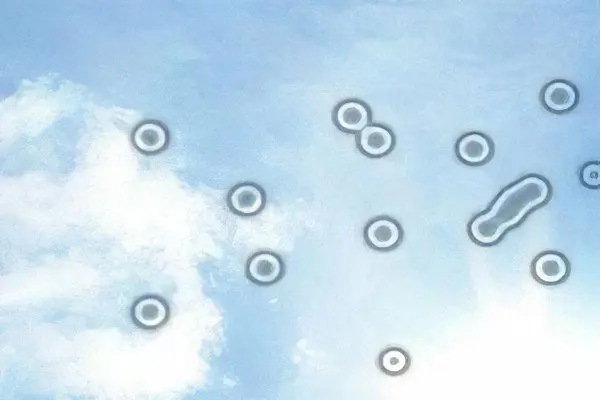
Rainbow circles. It is rainbow circles that are a sign that most often indicates developing glaucoma. They occur when a person directs his gaze to a light source. The object itself will be dark, but surrounded by a rainbow halo. Closer to the light source, the color is purple, and farther from it, it is red. In the center, all shades of the rainbow are observed.
Comparative characteristics of rainbow circles in various ophthalmic diseases:
Conjunctivitis. A rainbow rim around an object occurs when a person looks at a light source. After excess mucus is removed from the eye, the bright halo dissipates.
Cataract. Circles appear frequently. Their provoking factor is the ingress of certain contaminants into the eye.
Glaucoma. With this pathology, circles do not disappear if pollution or mucus is removed from the eye. They always arise when a person looks at a light source.
Blurred vision. Periodically, people with glaucoma have fog in front of their eyes. This leads to the fact that it will be difficult for a person to examine in detail the objects that surround him. He has the impression that they are covered with a light haze. Sometimes blurred vision is so intense that the patient cannot even clearly determine the boundaries of objects and their color. The reason for the appearance of such a fog is an increase in intraocular pressure against the background of which swelling of the cornea occurs. A similar symptom can persist for a long time: from several minutes to several hours.
Head and eye pain. Headache often accompanies developing glaucoma, but a person rarely correlates these two phenomena with each other. This is especially true when the disease affects both eyes at once. It is easier to suspect glaucoma from a headache in the case when the pathology develops in only one eye. Painful sensations are concentrated in the temporal region on the side where glaucoma manifested. The pain pulsates, proceeds as a spasm.
Lachrymation. Normally, tears do not flow from the eyes on a regular basis. However, with glaucoma, there is a failure in the outflow and inflow of intraocular fluid, as well as an increase in pressure inside the eye. Therefore, the production of tear fluid increases. This symptom requires a visit to the doctor.
False moistening of the eye. A person with glaucoma may feel like their eyes are filling with tears. If he tries to get them wet, he will find that there are actually no tears. This feeling arises due to the fact that the patient has increased intraocular pressure.
If a person discovers one or several symptoms at once, indicating the early development of glaucoma, he needs to consult a doctor.

When should you see a doctor?
There are three signs that can indicate developing glaucoma, but at the same time, they characterize many other diseases. In any case, their appearance requires an appeal to an ophthalmologist.
These are symptoms such as:
The appearance of flies before the eyes.
Rapid fatigue of the organs of vision.
Fatigue of the optic nerve after short exertion.
When they appear, you need to immediately undergo an examination.
Treatment of glaucoma

Glaucoma leads to irreversible consequences. Therefore, the sooner a person gets an appointment with an ophthalmologist, the faster it will be possible to stop the progression of the disease and the less harm it will cause to vision.
The main goal of therapy is to reduce intraocular pressure. Sometimes it can be solved through the use of eye drops, and sometimes you have to resort to the help of a surgeon.
Eye drops for the treatment of glaucoma
You can relieve intraocular pressure with eye drops. Their action is based on the fact that the outflow of fluid from the eyes is normalized.
Drugs that can be used to treat glaucoma include:
Drops containing prostaglandins. They help reduce intraocular pressure. After the installation, patients often experience redness of the mucous membrane of the eye, a tingling sensation, darkening of the iris, and blurred vision. Sometimes there is a change in the color of the eyelashes. Such medicines include drops Reskula, Travatan, Lumigan, Xalatan.
Beta blockers. These drugs interfere with the process of fluid production in the organs of vision. However, they have some side effects, including: hypotension, slow heart rate, reduced potency, increased fatigue. These eye drops include: Betoptik C, Timoptik XE, etc.
carbonic anhydrase inhibitors. These drugs are not often prescribed for glaucoma. They help reduce the production of intraocular fluid, but can lead to a metallic taste in the mouth, increased urination, and tingling in the fingers. Representatives of this group: Azopt, Trusopt, etc.
Agonists of alpha-adrenergic receptors. These drops are aimed at reducing the production of eye fluid and improving its outflow. The use of drugs is associated with the risk of developing hypertension, arrhythmias. Sometimes they cause dry mouth. These are drugs such as: Lopidin, Alfagan, Alfagan-P.
Oral preparations
Sometimes local therapy is not enough. In this case, the doctor may prescribe systemic drugs to the patient. In glaucoma, carbonic anhydrase inhibitors are used: Daranid, Diamox, Neptazan. However, about half of the patients refuse such therapy, since the side effects of these drugs are very intense.
Glaucoma surgery
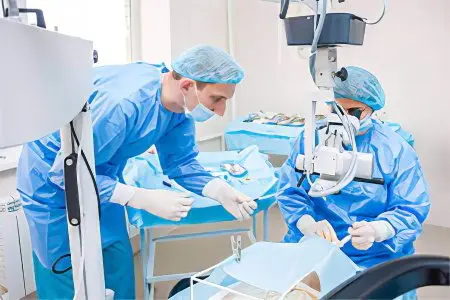
The operation is prescribed for all patients with primary open-angle glaucoma. It will not be possible to cope with pathology with drugs. The patient underwent surgery under local anesthesia. The method of linear trabeculoplasty is often used. A goniolens is used to perform surgical manipulations.
Deep and non-penetrating sclerectomy can also be performed to treat open-angle glaucoma. The procedure is aimed at reducing intraocular pressure by thinning the area of the peripheral cornea. This allows intraocular fluid to better seep through its membrane. To prevent the formation of scar tissue on the eye, a collagen drain may be installed in the patient.
The operation to get rid of glaucoma is actually not as dangerous as it might seem. Its duration is about 20 minutes. The person is not left in the hospital. After the procedure is completed, he is under the supervision of a doctor for several hours, after which he is sent home. Next time he should visit the doctor in a few days. At home, you will need to use special eye drops. The doctor will prescribe them.
Types of surgical care
Patients with an acute attack of glaucoma are hospitalized. Treatment can be reduced to medical correction, although sometimes it is impossible to do without the help of a surgeon. Each attack of the disease is accompanied by a significant increase in the level of intraocular pressure. It threatens with complete blindness. It will not be possible to restore vision in the future. If help is provided on time, then the function of the eyeball may return to normal. However, it is also impossible to exclude the possibility of complications after the surgery. There is always a risk, but without such treatment, the likelihood of vision loss is much higher.
Operations that are performed for glaucoma can be of the following types:
Sclerectomy non-penetrating (non-fistilizing). This method is used to treat open-angle glaucoma. The result of the operation is a decrease in intraocular pressure by thinning a limited area of the peripheral cornea. In some cases, collagen drains are placed to minimize tissue scarring.

This method of treatment is not as scary as it might seem. The operation lasts only 20 minutes, and after that you can go home in a couple of hours. After the operation, eye drops prescribed by the doctor are used at home.
Trabeculectomy. This is a penetrating intervention.
Cyclocoagulation. The operation is aimed at reducing the production of intraocular fluid.
Iridectomy or iridocycloretraction. Both operations are aimed at normalizing the process of fluid circulation inside the eye.
iStent. This is a minimally invasive innovative method for the treatment of glaucoma. The procedure is carried out on a special device. Treatment allows you to normalize the outflow of fluid from the eye and safely for the patient to reduce intraocular pressure.
iStent
Let’s dwell on this method in more detail. iStent refers to microinvasive surgery and has some advantages over other types of surgery.
They include:
Short recovery period.
Low likelihood of complications.
Stopping the progression of the disease in the early stages of its development.
The patient will not be bedridden.
There is no need to take medication after the operation.
The iStent procedure also has certain advantages.
These include:
The safety of the procedure.
During the operation, the tissues of the eye are not cut, but pushed apart.
The technique can be practiced in combination with other treatments.
The iStent itself is a small device (it is the smallest of all devices that have ever been used in medicine). The doctor places it in the patient’s eye. At the same time, the patient himself does not see or even feel it.

The device makes a hole in the trabecular meshwork. Through it, excess fluid will come out of the eye. The iStent is inserted through an incision that is no larger than 15 mm. The technique can be used to treat open-angle glaucoma of any severity. The age of the patient does not matter.
Sometimes another operation is required to completely get rid of glaucoma. Fistulizing techniques are rarely used. Penetration into the eye cavity may be required for patients with progressive glaucoma, as well as for those people in whom gentle treatment methods have not brought the desired result.
Recovery after surgery
If the disease was detected in the early stages, then the operation can be performed using a laser beam. Most specialists prefer this particular method of treatment. The procedure allows you to reduce intraocular pressure, improve the outflow of intraocular fluid and not prevent the development of complications of the disease.
Before admitting the patient to surgery, the doctor conducts a comprehensive examination. This will allow you to choose the optimal method of therapy.
To reduce the likelihood of recurrence of the disease, you must strictly follow all the recommendations of a specialist. You should regularly visit an ophthalmologist and use the drugs that he prescribes.
Besides:
In summer and spring, when the sun shows increased activity, it is necessary to use special anti-glaucoma glasses.

Excessive eye strain is not allowed. Do not watch TV or work at the computer for too long. Lighting should always be of high quality.
Diseases that can provoke visual complications should be treated in time.
After surgery for the treatment of glaucoma, the patient’s eyes may be very watery, sometimes there is irritation of the organ of vision. Blurred vision may persist for several weeks. It takes about 2 months. Over time, the function of the eye stabilizes. For faster recovery, Pilocarpine must be used. This drug normalizes the size of the pupil. The doctor may also advise the patient to wear lenses or glasses. It is important to observe hygiene measures aimed at preventing infection of the organ of vision.











